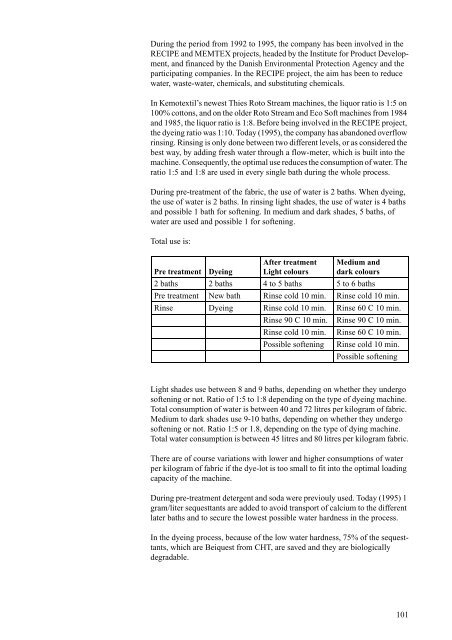Cleaner Technology Transfer to the Polish Textile ... - Miljøstyrelsen
Cleaner Technology Transfer to the Polish Textile ... - Miljøstyrelsen
Cleaner Technology Transfer to the Polish Textile ... - Miljøstyrelsen
Create successful ePaper yourself
Turn your PDF publications into a flip-book with our unique Google optimized e-Paper software.
During <strong>the</strong> period from 1992 <strong>to</strong> 1995, <strong>the</strong> company has been involved in <strong>the</strong><br />
RECIPE and MEMTEX projects, headed by <strong>the</strong> Institute for Product Development,<br />
and financed by <strong>the</strong> Danish Environmental Protection Agency and <strong>the</strong><br />
participating companies. In <strong>the</strong> RECIPE project, <strong>the</strong> aim has been <strong>to</strong> reduce<br />
water, waste-water, chemicals, and substituting chemicals.<br />
In Kemotextil’s newest Thies Ro<strong>to</strong> Stream machines, <strong>the</strong> liquor ratio is 1:5 on<br />
100% cot<strong>to</strong>ns, and on <strong>the</strong> older Ro<strong>to</strong> Stream and Eco Soft machines from 1984<br />
and 1985, <strong>the</strong> liquor ratio is 1:8. Before being involved in <strong>the</strong> RECIPE project,<br />
<strong>the</strong> dyeing ratio was 1:10. Today (1995), <strong>the</strong> company has abandoned overflow<br />
rinsing. Rinsing is only done between two different levels, or as considered <strong>the</strong><br />
best way, by adding fresh water through a flow-meter, which is built in<strong>to</strong> <strong>the</strong><br />
machine. Consequently, <strong>the</strong> optimal use reduces <strong>the</strong> consumption of water. The<br />
ratio 1:5 and 1:8 are used in every single bath during <strong>the</strong> whole process.<br />
During pre-treatment of <strong>the</strong> fabric, <strong>the</strong> use of water is 2 baths. When dyeing,<br />
<strong>the</strong> use of water is 2 baths. In rinsing light shades, <strong>the</strong> use of water is 4 baths<br />
and possible 1 bath for softening. In medium and dark shades, 5 baths, of<br />
water are used and possible 1 for softening.<br />
Total use is:<br />
After treatment Medium and<br />
Pre treatment Dyeing Light colours dark colours<br />
2 baths 2 baths 4 <strong>to</strong> 5 baths 5 <strong>to</strong> 6 baths<br />
Pre treatment New bath Rinse cold 10 min. Rinse cold 10 min.<br />
Rinse Dyeing Rinse cold 10 min. Rinse 60 C 10 min.<br />
Rinse 90 C 10 min. Rinse 90 C 10 min.<br />
Rinse cold 10 min. Rinse 60 C 10 min.<br />
Possible softening Rinse cold 10 min.<br />
Possible softening<br />
Light shades use between 8 and 9 baths, depending on whe<strong>the</strong>r <strong>the</strong>y undergo<br />
softening or not. Ratio of 1:5 <strong>to</strong> 1:8 depending on <strong>the</strong> type of dyeing machine.<br />
Total consumption of water is between 40 and 72 litres per kilogram of fabric.<br />
Medium <strong>to</strong> dark shades use 9-10 baths, depending on whe<strong>the</strong>r <strong>the</strong>y undergo<br />
softening or not. Ratio 1:5 or 1.8, depending on <strong>the</strong> type of dying machine.<br />
Total water consumption is between 45 litres and 80 litres per kilogram fabric.<br />
There are of course variations with lower and higher consumptions of water<br />
per kilogram of fabric if <strong>the</strong> dye-lot is <strong>to</strong>o small <strong>to</strong> fit in<strong>to</strong> <strong>the</strong> optimal loading<br />
capacity of <strong>the</strong> machine.<br />
During pre-treatment detergent and soda were previouly used. Today (1995) 1<br />
gram/liter sequesttants are added <strong>to</strong> avoid transport of calcium <strong>to</strong> <strong>the</strong> different<br />
later baths and <strong>to</strong> secure <strong>the</strong> lowest possible water hardness in <strong>the</strong> process.<br />
In <strong>the</strong> dyeing process, because of <strong>the</strong> low water hardness, 75% of <strong>the</strong> sequesttants,<br />
which are Beiquest from CHT, are saved and <strong>the</strong>y are biologically<br />
degradable.<br />
101

















